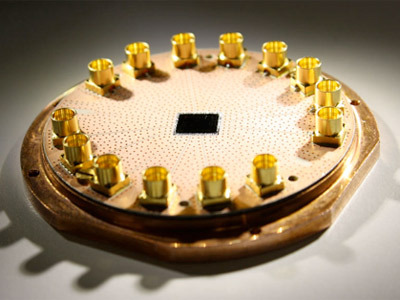Beaming up information with quantum teleportation
University of Queensland (UQ) physicists have successfully ‘teleported’ an atom, transmitting it from one location to another inside an electronic chip. This marks the first time quantum teleportation has been achieved in a solid-state system.
The team includes Dr Arkady Fedorov and Dr Matthias Baur, who recently moved to UQ’s ARC Centre of Excellence for Engineered Quantum Systems from ETH Zurich, where the research was conducted. Other members from ETH Zurich include L Steffen, Y Salathe, M Oppliger, P Kurpiers, M Baur, C Lang, G Puebla-Hellmann and Andreas Wallraff.
Dr Fedorov described quantum teleportation as “a process by which quantum information can be transmitted from one place to another without sending a physical carrier of information”. In this case, it was used to relay information from one corner of an integrated electronic circuit to the other in a way that is impossible in a classical world.
“In this process the information just appears at the destination,” said Dr Fedorov, “almost like teleportation used in the famous science fiction series Star Trek.”

Dr Fedorov said the team’s macroscopic quantum system uses a circuit “much like modern computer chips”. The quantum information is stored in quantum bits (qubits) - artificial structures which can be seen with the naked eye.
In order to teleport the information one needs three qubits in total, with two being prepared in an entangled state. Entanglement is a special type of correlation shared between a sender and a receiver, said Dr Fedorov, and once it is created, “this ‘impossible’ information transfer becomes in fact possible thanks to laws of quantum mechanics”.
Dr Fedorov said the qubits allowed the researchers “to do teleportation with impressive speed and accuracy above the classical threshold”. While in other experiments teleportation occurs every few seconds, “our system allows us to teleport a quantum state more than 10,000 times per second”.
The breakthrough was enabled through a measurement scheme that distinguishes between all four entangled Bell states in a single-shot measurement. The team’s device uses a crossed quantum bus technology that improves scalability in these systems and will lead to larger and more complex systems in the future.
Dr Fedorov said the technology is being used in UQ’s Superconducting Quantum Devices Laboratory “to further enhance our knowledge of quantum information processing”. Eventually it will be used to create more powerful devices, he said, such as larger electronic networks and more functional electronic chips.
This research indicates that questions relating to the physics of quantum communication can be addressed using electronic circuits at microwave frequencies. In future experiments, quantum entanglement may even be distributed over larger distances directly by microwave photons or using microwave to optical interfaces for quantum communication.
Teleportation is expected to find applications in secure communication and in more efficient information processing based on the laws of quantum physics.
European Space Agency inaugurates deep space antenna in WA
The ESA has expanded its capability to communicate with scientific, exploration and space safety...
Black hole collision supports Hawking's landmark theory
Astrophysicists have witnessed a collision between two black holes that was so loud, they were...
Uncovering differences in wild and domesticated crops
Researchers have revealed insights into the genetic make-up of wild varieties of common crops...



